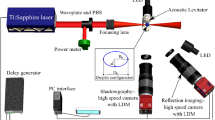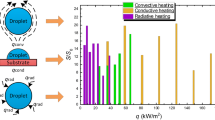Abstract
Weak spherical blast waves in static air and their breakup of ethanol and Jet A-1 kerosene droplets were investigated. The blast waves were created by laser-induced air breakdowns at ambient temperature and pressure. In the first part of this study, they were visualized with schlieren imaging, and their trajectories were tracked with high temporal resolution. The laser pulse energy was varied to create blast waves of different strengths. Their initial energies were determined by the application of a numerical and a semi-empirical blast wave model. In the second part, monodisperse ethanol and kerosene droplet chains were injected. Their interaction with the blast waves was visualized by the application of shadowgraph imaging. The perpendicular distance of the breakdown origin toward the droplet chains was varied to study the effect on the fuel droplets as a function of the distance. Droplets within a few millimeters around the breakdown origin were disintegrated into two to three secondary droplets. The blast-induced flow velocities on the post-shock side and the corresponding Weber numbers were calculated from the data of a non-dimensional numerical simulation, and a close look was taken at the breakup process of the droplets. The analysis showed that the aerodynamic force of the blast-induced flow was sufficient to deform the droplets into disk-like shapes, but diminished too fast to accomplish breakup. Due to the release of strain energy, the deformed droplets relaxed, stretched into filaments and finally disintegrated by capillary pinching.















Similar content being viewed by others
References
Gebel, G.C., Mosbach, T., Meier, W., Aigner, M.: Optical and spectroscopic diagnostics of laser-induced air breakdown and kerosene spray ignition. Combust. Flame 162, 1599–1613 (2015)
Ronney, P.D.: Laser versus conventional ignition of flames. Opt. Eng. 33, 510–521 (1994)
Gebel, G.C., Le Brun, S., Mosbach, T., Meier, W., Aigner, M.: An experimental investigation of kerosene droplet breakup by laser-induced blast waves. J. Eng. Gas Turb. Power 135, 021505 (2013)
Joarder, R., Gebel, G.C., Mosbach, T.: Two-dimensional numerical simulation of a decaying laser spark in air with radiation loss. Int. J. Heat. Mass Transf. 63, 284–300 (2013)
Pilch, M., Erdman, C.A.: Use of breakup time data and velocity history data to predict the maximum size of stable fragments for acceleration-induced breakup of a liquid drop. Int. J. Multiphase Flow 13, 741–757 (1987)
Gelfand, B.E.: Droplet breakup phenomena in flows with velocity lag. Prog. Energy Combust. Sci. 22, 201–265 (1996)
Guildenbrecher, D.R., López-Rivera, C., Sojka, P.E.: Secondary atomization. Exp. Fluids 46, 371–402 (2009)
Engel, O.G.: Fragmentation of waterdrops in the zone behind an air shock. J. Res. Nat. Bureau Stand. 60, 245–280 (1958)
Ranger, A.A., Nicholls, J.A.: Aerodynamic shattering of liquid drops. In: Proceedings of 6th AIAA Aerospace Science Meeting, New York, AIAA, pp. 68–83 (1968)
Hsiang, L.-P., Faeth, G.M.: Drop deformation and breakup due to shock wave and steady disturbances. Int. J. Multiphase Flow 21, 545–560 (1995)
Widdecke, N., Klenk, W., Frohn, A.: Impact of strong shock waves on monodisperse isopropanol droplet streams. In: Brun, R., Dumitrescu, L.Z. (eds.) Shock Waves @ Marseille III, pp. 89–94. Springer, Berlin (1995)
Theofanous, T.G., Li, G.J., Dinh, T.N.: Aerobreakup in rarefied supersonic gas flows. J. Fluids Eng. 126, 516–527 (2004)
Strutt, J.W. 3rd Baron Rayleigh: on the instability of jets. Proc. Lond. Math. Soc. 10, 4–13 (1878)
Chen, Y.-L., Lewis, J.W.L., Parigger, C.: Spatial and temporal profiles of pulsed laser-induced air plasma emissions. J. Quant. Spectrosc. Radiat. Transf. 67, 91–103 (2000)
Phuoc, T.X.: Laser-induced spark ignition fundamental and applications. Opt. Lasers Eng. 44, 351–397 (2006)
Taylor, G.: The formation of a blast wave by a very intense explosion. I. Theoretical discussion. Proc. R. Soc. Lond. A 201, 159–174 (1950)
Taylor, G.: The formation of a blast wave by a very intense explosion. II. The atomic explosion of 1945. Proc. R. Soc. Lond. A 201, 175–186 (1950)
Sedov, L.I.: Similarity and Dimensional Methods in Mechanics. Academic Press, New York (1959)
Brode, H.L.: Point Source Explosion in Air. Report RM-1824-AEC, The RAND Corporation (1956)
Jones, D.L.: Intermediate strength blast waves. Phys. Fluids 11, 1664–1667 (1968)
Jones, D.L.: Erratum: Strong blast waves in spherical, cylindrical, and plane shocks. Phys. Fluids 5, 637 (1962)
Brieschenk, S., Hruschka, R., O’Byrne, S., Kleine, H.: High-speed time-resolved visualization of laser-induced plasma explosions. 28th International Congress on High-Speed Imaging and Photonics, Canberra, SPIE, vol. 7126 (2009)
Dewey, J.M.: Expanding spherical shocks (blast waves). In: Ben-Dor, G., Igra, O., Elperin, T. (eds.) Handbook of Shock Waves, vol. 2. Shock Wave Interactions and Propagation, pp. 441–481. Academic Press, New York (2001)
Phuoc, T.X., White, F.P.: An optical and spectroscopic study of laser-induced sparks to determine available ignition energy. Proc. Combust. Inst. 29, 1621–1628 (2002)
Vázquez, G., Alvarez, E., Navaza, J.M.: Surface tension of alcohol + water from 20 to \(50^{\circ }\text{ C }\). J. Chem. Eng. Data 40, 611–614 (1995)
Defence Standard 91-91, Issue 7. UK Ministry of Defence (2011)
Handbook of Aviation Fuel Properties, 3rd edn. Report 635, Coordinating Research Council (2004)
Rachner, M.: The properties of kerosine Jet A-1. Report 98–01, German Aerospace Center (1998)
Brode, H.L.: Numerical solutions of spherical blast waves. J. Appl. Phys. 26, 766–775 (1955)
Hinze, J.O.: Fundamentals of the hydrodynamic mechanism of splitting in dispersion processes. Am. Inst. Chem. Eng. J. 1, 289–295 (1955)
Khare, P., Ma, D., Chen, X., Yang, V.: Phenomenology of secondary breakup of Newtonian liquid droplets. In: Proceedings of 50th AIAA Aerospace Science Meeting, Nashville, AIAA 2012-0171 (2012)
Ashgriz, N., Movassat, M.: Oscillation of droplets and bubbles. In: Ashgriz, N. (ed.) Handbook of Atomization and Sprays, pp. 125–144. Springer, Berlin (2011)
Tjahjadi, M., Stone, H.A., Ottino, J.M.: Satellite and subsatellite formation in capillary breakup. J. Fluid Mech. 243, 297–317 (1992)
Stone, H.A.: Dynamics of drop deformation and breakup in viscous fluids. Anu. Rev. Fluid Mech. 26, 65–102 (1994)
Author information
Authors and Affiliations
Corresponding author
Additional information
Communicated by D. Ranjan.
This paper is based on work that was presented at the 29th International Symposium on Shock Waves, Madison, Wisconsin, USA, July 14–19, 2013.
Rights and permissions
About this article
Cite this article
Gebel, G.C., Mosbach, T., Meier, W. et al. Laser-induced blast waves in air and their effect on monodisperse droplet chains of ethanol and kerosene. Shock Waves 25, 415–429 (2015). https://doi.org/10.1007/s00193-015-0564-5
Received:
Revised:
Accepted:
Published:
Issue Date:
DOI: https://doi.org/10.1007/s00193-015-0564-5




